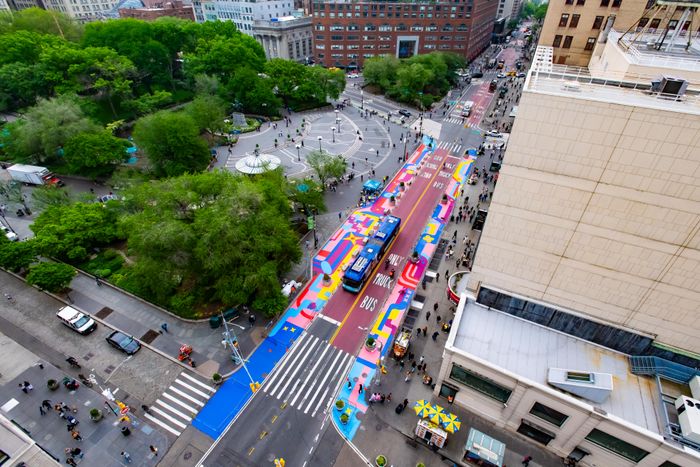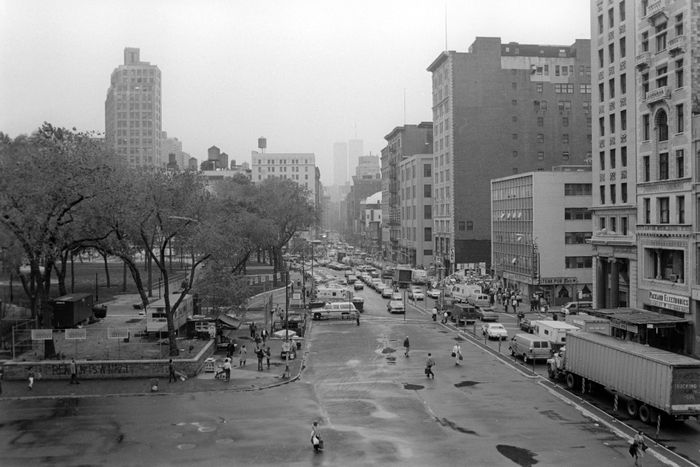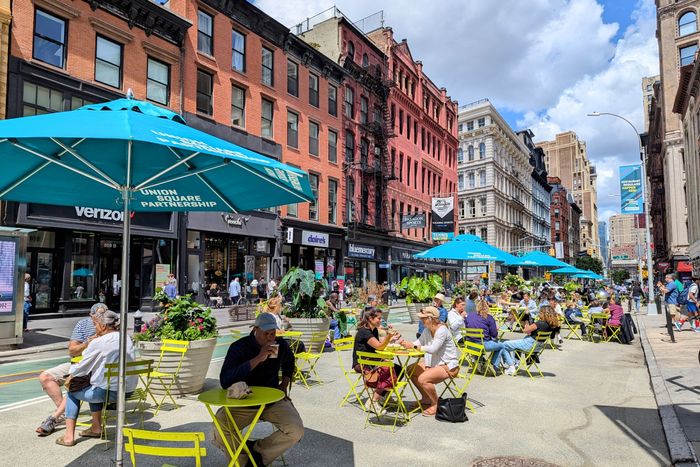The potential 14th Street of the future, as seen in a rendering from the Union Square Partnership’s 2021 vision plan.
Photo: Marvel/Courtesy of Union Square Partnership
“This is almost obvious,” Julie Stein says, gesturing down the sidewalk toward Fourth Avenue. Stein is the executive director of the Union Square Partnership, the business-improvement district, or BID, covering the area around East 14th Street. It’s hopping today around Union Square, with the customary light chaos of street vendors and packs of NYU kids getting coffee. Up ahead of us, the asphalt is brightly painted with a mural-ish artwork, renewed each year, that’s part of the 14th Street Busway project inaugurated in 2020. We’re walking the area with Emily Weidenhof, an assistant commissioner from the Department of Transportation, and Ya-Ting Liu, the city’s first chief public-realm officer, all of whom want to talk about the big forthcoming (and, yes, almost obvious) proposal to remake this wide, sometimes charming, sometimes bleak thoroughfare from river to river.
It’s a plan with many stakeholders. Besides the Union Square BID and the DOT, there’s also the Meatpacking District BID and the MTA and councilmembers and community boards, not to mention anyone with an opinion and a mouth. Their (mostly) shared goal is to make 14th into what’s often called a “complete street,” one where pedestrians, bikers, delivery people, transit, and some cars all get their respective shares of the pavement. That might sound like what we already have, but it isn’t; the dominant mode of most city streets today is still a private-car-oriented one, and even though 14th is not quite that, it is far from complete.
Mind you, most of the ideas they’re pitching are not especially new. The plan for 14th Street is partly an attempt to codify and build a variety of improvements that have been proposed in the past few years, including those in the USP’s 2021 district vision plan, which in large part aimed to make the boundaries between the park and the surrounding streets more porous. It’ll also give steel-and-concrete permanence to the 14th Street Busway, which limits auto traffic between Third and Eighth Avenues to drop-offs and single-block turnarounds, letting trucks and buses move freely instead of oozing along. (It’s been a quiet success, enough so that a sequel is under discussion.) But the busway until now has been demarcated mostly with painted lanes and other inexpensive, reversible measures. The Adams administration is about to announce that it’s putting money toward reshaping it all — not for a reconstruction just yet, but $1.5 million for a proper study of traffic flow, street dynamics, and the potential effects of every proposed change. The BIDs representing Union Square and the Meatpacking District have raised another $1 million toward that study, which will take 24 months.
One of the streetside plaza platforms newly installed in the Meatpacking District east of Tenth Avenue.
Photo: Iri Greco/Brake Through Media
Remaking 14th Street at this scale is intended not just for grownups at play and work, the ones who might want somewhere to sit with their coffee and phones, but for business owners in the area as well. The idea is that this type of investment will make the area a more desirable destination and thus lead to all the benefits that come from more foot traffic and spending. Stein and Weidenhof are a little cautious about the specifics of exactly what will or won’t be built — a lot will depend on that study’s results, and the details all get hashed out in the review process thereafter — but certain things are almost sure to be part of it. More trees, certainly, in planters and in pits. Benches, bike racks, better street furniture in general. Some modern DOT-standard lampposts to replace odd models installed a generation ago. The area really needs delivery-vehicle hubs. A more permanent version of the bus-bulb platforms that extend the curb by ten feet or so, now made of plastic and imported from Spain. (They’re pretty good additions to the streetscape, but Weidenhof says they are also expensive to maintain.) The ideas also include taking away some curbs altogether. Ideally, the plaza at the south end of Union Square Park would spill out curblessly into the street itself. If the traffic study reveals a way to do it, that odd little isolated triangle of green at the southeast corner of the square, now boxed in by roadways, could be integrated into the park. Some of Union Square West, parts of which are already closed to traffic, can become sidewalk-café-table territory for the neighboring restaurants.
Quite a bit of this type of change has already happened at the square’s north end, where a bit of Broadway has been transformed into a great mixed-use plaza. That stretch of not-quite-car-free-but-car-light roadbed reaches up to the Flatiron Building at 23rd Street. It is not hard to envision that run of shared-use complexity eventually hooking up with the similar areas running north and south from Herald Square, and then up to Times Square as well, and perhaps even in some future to Columbus Circle and the Upper West Side. The last time so many non-drivers held dominion over Broadway, the Model T was still in production.
As we make our way across 14th, the group expresses optimism about what’s been done so far and is ebullient about what could be done. Each block, they point out, will need a slightly different scheme, because every one is its own urban microclimate. The stretch from Second to Third, for example, is mostly full of small buildings and small businesses. Stein also points out that it’s one of the few parts of 14th that already has sizable trees, planted a generation ago. They make it noticeably cooler on the sidewalk. At mid-block, there’s an ad hoc staging area in front of an e-bike shop, and it’s chaotic with delivery guys waiting to be summoned. That situation will have to be rationalized and given some streetside real estate. That’s a particularly thorny issue — “e-bikes are so hard,” Liu says to me, eyeing the scene — because everyone wants speedy deliveries but almost nobody wants to give up street space to the people doing the work. The latest change in that realm is the city’s recent announcement of a Department of Sustainable Delivery, intended to shift some responsibility from individual contractors to the app companies like Seamless that employ them. This particular e-bike corral will likely end up being a dedicated area with charging stations, probably around the corner somewhere on one of the avenues. But, as the cliché goes, further review is needed.
Compare that block to the ones between Fifth and Seventh, lined largely with very large apartment and office buildings and a few walk-ups. The mix of retail is peculiar and nonuniform, ranging from big national chains (Guitar Center) to useful oddities (a place that sells every kind of lightbulb and lamp part). Or the blocks over toward Avenue A and B, which are dominated by the southern edge of Stuy Town, with comparatively little retail street frontage and a protected access lane. All will require somewhat different interventions. That is, too, what this study is meant to suss out. Tune in for details in the fall of 2027.
_
As the Union Square Partnership pushes from the east, Jeffrey LeFrancois is leaning in from the west. He runs the Meatpacking District Management Association, the BID whose territory starts at West Street and runs inland as far as Eighth Avenue. The cobbled and umbrella’d plaza on Ninth, in front of the Apple Store and Chelsea Market, has established itself as an exceedingly pleasant gathering place over the past few years. Last month, the city expanded upon it, dedicating the adjoining Promenade on the cobbled block of 14th between Ninth and Tenth Avenues. It’s a useful preview of what the larger complete street can be. Eighteen feet of roadway, nine on each side, has been staked out with five curb-height platforms. They’re set off from traffic by planters and irregular hunks of granite, essentially giant versions of the Belgian blocks that make up the pavement here. “Not the DOT’s standard ones,” LeFrancois says, noting that they were a handsome but more expensive choice.
The 14th Street busway at Union Square South in its current painted-on incarnation.
Photo: Jane Kratochvil
The automobile-centric recent past, seen here in 1985.
Photo: Fairchild Archive/Penske Media/Getty Images
These platforms are fitted out with seating, both loungey long chairs and a sort of high-counter-with-stools arrangement akin to a coffee bar’s. LeFrancois is effusive about them, both because they “create passive and active engagement along the corridor” — that is, people drift in to meet friends, have a beverage, just get out the sun for a moment — but also because they create useful negative space. That is, between these platforms is an area where a delivery truck can pull over, or a CitiBike dock can be added, or a commercial kiosk could be installed at some point in the future. The seating, I notice, lacks those spikes and ribs and other hostile features that would keep putatively undesirable people from settling in. “I felt very strongly that we can’t design for fear,” he says. One potential future of the district, LeFrancois adds, would incorporate more of these platforms, each affiliated with an individual tenant nearby, approximating some of the dining-shed experience in a less splintery setting. “The wine bar, the beer-hall-type thing, panini, coffee — whatever it is,” he says. Around the corner by the Whitney, where Gansevoort Street ends near the river, a small corner plaza does more of the same work. Known as Gansevoort Landing, it’s delineated mostly with paint right now, although LeFrancois would love to build it up long-term. There’s much more on his mind, too, particularly remaking the exit from West Street/9A at the foot of 14th Street, where the cars roar in and make the turn up Tenth Avenue at high speed.
Plenty of individuals in plenty of neighborhoods would like this stuff to happen to their streets. Here, critically, most of the groups with power are lined up together, approximately in unison or at least in harmony, and that makes a big difference. The BIDs have influence over about half of 14th Street; the Union Square folks’ dominion covers First to Sixth Avenues, the Meatpacking group’s from Eighth to the Hudson. For the section at the far east, from First Avenue to Avenue C, where Stuyvesant Town sits to the north, Stein says that the Stuy folks are supportive. That leaves a two-block hole in the middle, between Sixth and Eighth, where the Department of Transportation does most of the managing. Right now that’s the least prettified part of the street, not much more than an open highway. But the DOT, beginning in the Bloomberg years under his commissioner Janette Sadik-Khan, has shifted from being a traditional traffic-management agency to a genuine force for modernizing the streetscape, and it’s actively working to bring the standards up here. Weidenhof and Stein are very quick to point out that the public-private partnership driving all this work, if not quite unprecedented, is unusually friendly and fruitful, and so is the group effort of the two BIDs, east and west. In short, there’s a lot of support from multiple parties from end to end.
Those parties also include Eric Adams, who talks a good game when it comes to complete streets but whose execution of those plans has been uneven. The forthcoming rehab of Fifth Avenue (another complete-streets plan) is substantial and really promising, and his administration has put $400 million behind it. On the other hand, the promise of hundreds of miles of protected bike lanes isn’t quite panning out, and the redesign opportunities provided by the street-dining experiment have largely been allowed to slip away. To his credit, though, Adams is supporting the 14th Street project, calling this plan “transformative” and “generational” and adding the following in a statement: “As part of our ‘Best Budget Ever,’ we were proud to work with the local BIDs and councilmembers to advance a study of 14th Street, which will usher in the future of this iconic corridor. We continue to think big and imagine what is possible on our streets and in our communities in service of our mission to make New York City a safer, more affordable city that is the best place to raise a family.” A cynic might say that his backing comes while he’s running against Zohran “fast free buses” Mamdani and Andrew “I fixed La Guardia and got a subway line going” Cuomo. But a good idea is a good idea, whatever its underlying motivational dynamics.
If it’s all “almost obvious,” as Stein put it, what’s the hangup? That “almost” contains a lot. In a scrupulously forward-thinking smaller city, like Copenhagen, or even a more sprawling one with big plans, like Paris, these would be fairly conservative changes deployed all over town by now. Here, though, the most minor alterations provoke a ton of shouting. The busway, which cost very little, was a strikingly difficult thing to push through, mostly because some local residents thought it would shunt traffic to the neighboring streets. (That turned out be a trivial issue.) Anything that takes away parking provokes a lot of hostility at community-board meetings. Someone always asks how the emergency-services vehicles will get through. Crankiness is, after all, a nearly sacred civic right in New York, and anything even hinting — accurately or not — at a limitation on businesses’ freedom to operate will face opposition.
Then comes the other source of snags: the differences among partners that develop as any plan comes together. Even if the BIDs and the DOT and the MTA and the locals and the community boards all want approximately the same outcome, their respective habits, practices, and interim goals inevitably lead to some disagreements. Navigating among them is a big part of Liu’s job, a new role Adams created in 2021 in order to help projects hack their way through interdepartmental tribalism.
As we walk up Union Square East, Stein points out a pile of garbage bins containing trash gathered from the park. It’s uncorralled and not very attractive, and because it’s July, it stinks. Settling on a way to manage that ten-foot stretch of sidewalk will require attention from the Department of Sanitation; the Department of Parks; the Department of Transportation; and, unofficially but significantly, the BID. You could very easily see that single negotiation turning into a six-month, full-time, bogged-down wrangle, and that’s for just one trash heap on one street. Multiply it by a thousand and add in bigger agencies that sometimes engage with projects like this (the MTA, the federal government, whoever), and you see the maddening pressures arrayed against getting anything like this done. “That’s the remit,” Liu says, nodding, and fortunately she sounds energized rather than defeated by it.
The seating area on Broadway at the top of Union Square, expanded last year.
Photo: Jane Kratochvil
One thing this plan has going for it is incrementalism. The busway was built with paint and a spirit of experimentation; now that it’s demonstrated that it’s an access, its advocates have the power to nudge it into permanence. The same is true for the plaza at the north end of the park and the new Promenade at the western end — they function as proofs of concept for a larger deployment of resources. Historically, schemes like this are least popular just before they get going: People wearily anticipate the headaches of construction and fear the results, and they reflexively turn negative and loud. Only when it’s done and in motion and they can see what they’re getting do they come around. Take congestion pricing, which was starkly unpopular before it launched, even among the people it was likeliest to benefit. As it’s been proven to work, its popularity has begun to turn for the better, and the big shift has been among people paying the toll — because they see that change is not the enemy.





